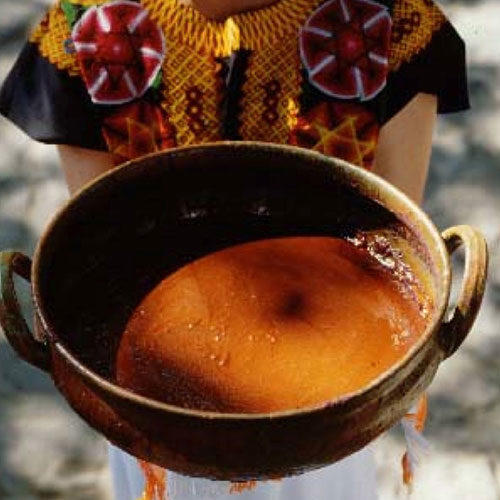Like mole amarillo, mole rojo belongs to the lighter, simpler end of the seven-moles spectrum. This version from the Isthmus of Tehuantepec is one of my favorites for easy preparation and versatile uses. Like all moles, it goes perfectly with pork or chicken and is a great sauce for enchiladas.
Mole rojo as I’ve encountered it in Oaxaca has usually been on the sweet side, typically enriched with raisins. I prefer this fresher-tasting approach, based on a recipe I found in a little English-language pamphlet of recipes by María Villalobos titled María’s Culinary Secrets.

Isthmian Red Mole (Mole rojo del Istmo)
Ingredients
- 1 small day-old French roll about 4 ounces, sliced, or 1 thick slice day-old challah or brioche
- 6 large pasilla or 4 large ancho chiles tops and seeds removed
- 6 cloves garlic unpeeled
- 1 large ripe tomato
- 1 small white onion quartered
- 1 1- inch piece
canela - ¼ teaspoon peppercorns
- 8 cloves or ¼ teaspoon ground
- 1 teaspoon dried Mexican oregano
- ½ teaspoon dried thyme
- 2 bay leaves
- 1½ cups homemade pork or chicken stock
- 3 tablespoons lard, preferably
home-rendered or vegetable oil - 1 teaspoon salt or to taste
- 1½ teaspoons sugar
Instructions
- Crush the bread to fine crumbs or grind in a food processor. You should have about 1 cup.
- Wash and griddle-dry the chiles. Place in a bowl, cover generously with boiling water, and let soak for at least 20 minutes.
- Roast the garlic cloves. When cool enough to handle, peel and set aside.
- Bring a small saucepan of water to a boil, add the tomato and onion, and cook over medium heat for 10 minutes. Remove the vegetables. Save ½ cup of the cooking liquid, let cool slightly, and place in a blender with the tomato, onion, and roasted garlic. Process until thoroughly puréed (about 2 minutes on high). With a wooden spoon or pusher, force the mixture through a medium-mesh sieve into a bowl. Set aside.
- Grind the canela, peppercorns, cloves, dried herbs, and bay leaves together in an electric coffee or spice grinder or with a mortar and pestle. Set aside.
- Drain the soaked chiles. Place in a blender (you don’t have to rinse it) with the stock and process until smooth (about 3 minutes on high), stopping occasionally to scrape down the sides with a rubber spatula. With a wooden spoon or pusher, force the mixture through a medium-mesh sieve into the bowl with the tomato purée.
- Now you are ready to combine and cook the ingredients. In a heavy medium-size saucepan, heat the lard over medium heat until rippling. Add the ground spices and cook for 2 minutes, stirring often. Stir in the tomato-chile mixture; cook, covered, for 10 minutes, stirring occasionally. Stir in the bread crumbs and cook for 2 minutes. If the sauce seems pasty, thin it with a little water or stock. Add the sugar; taste for seasoning and add a little more salt or sugar if desired.

